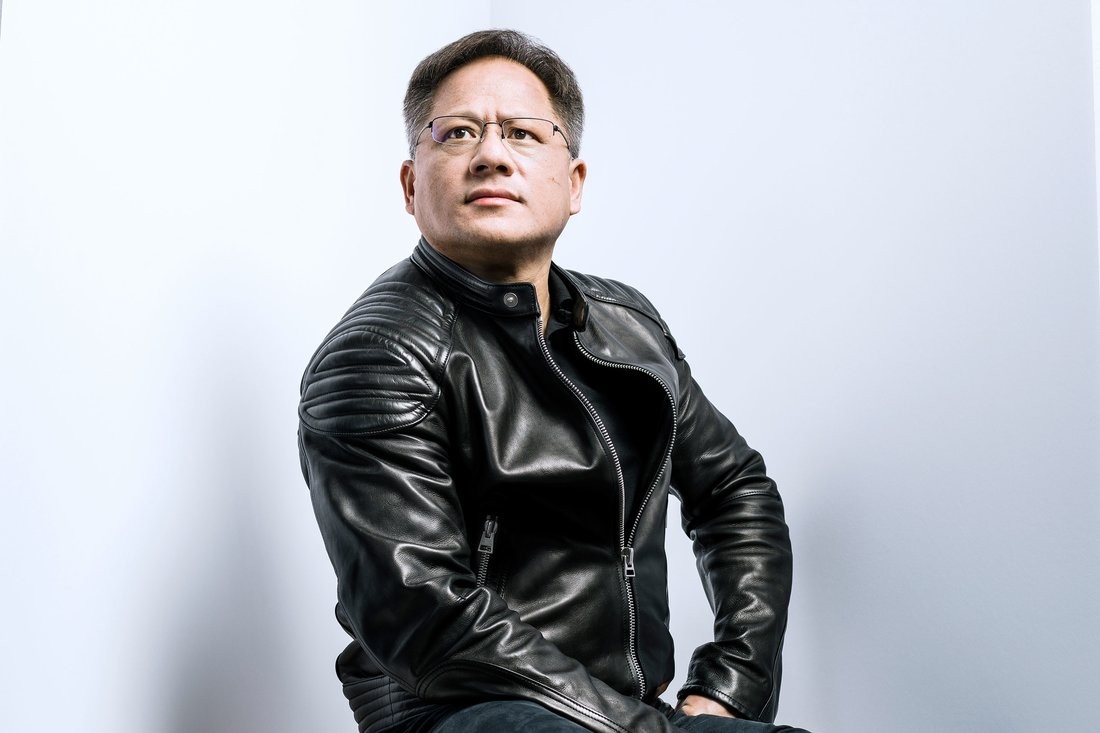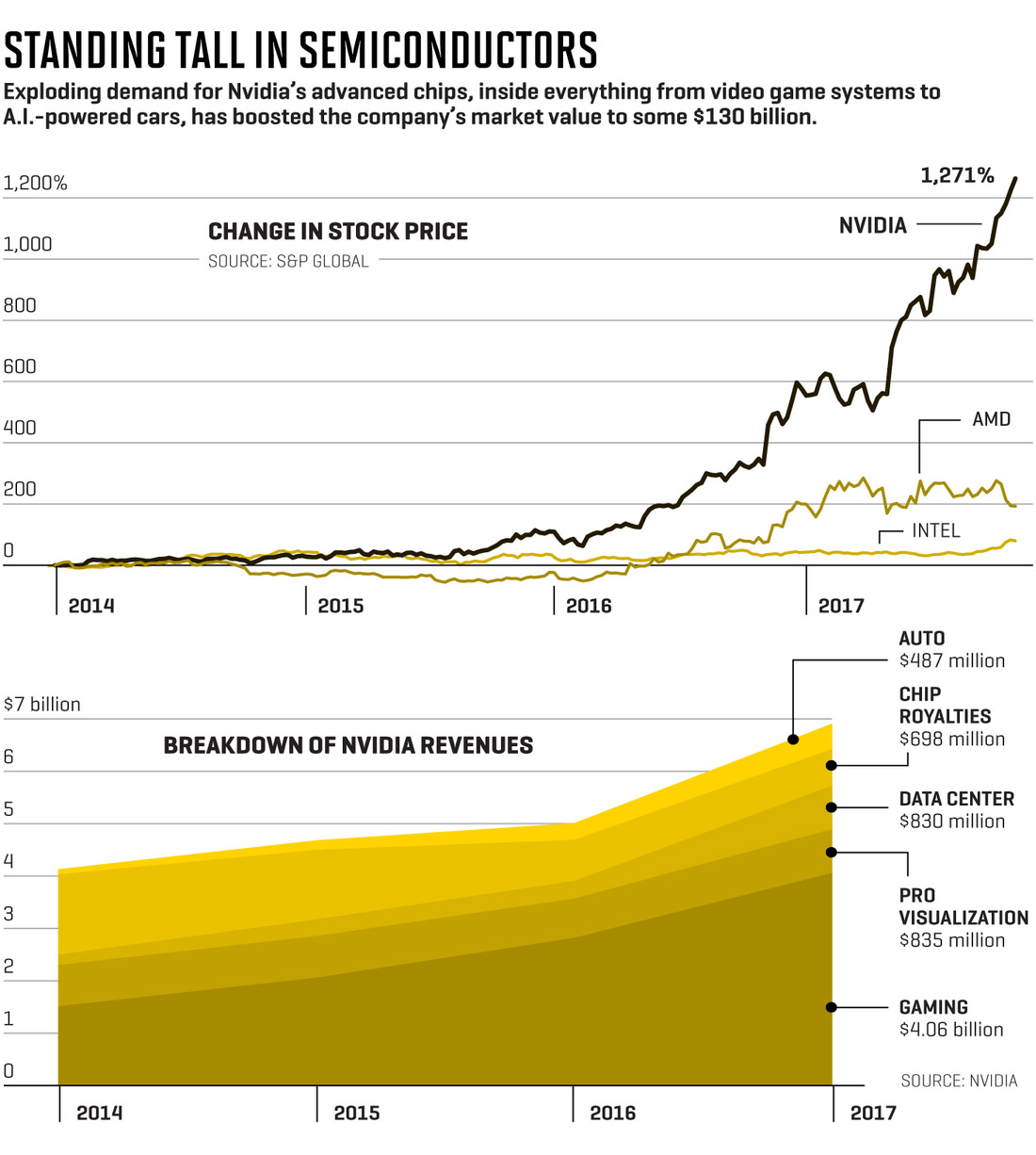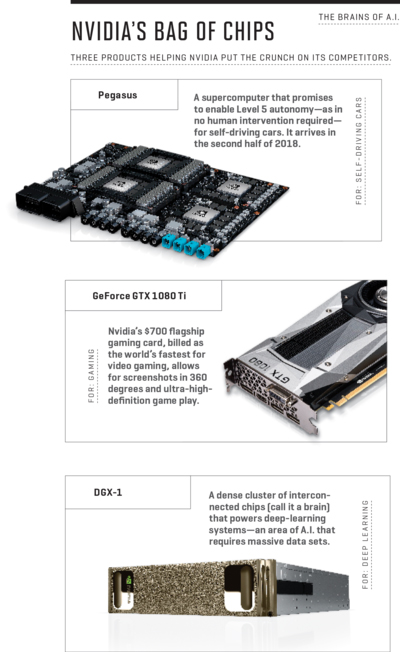《財(cái)富》2017年度商人:硅谷人工智能革命的引領(lǐng)者
|
在前往Evvia【這家位于帕洛阿爾托市中心的希臘餐廳熱鬧非凡,蘋果(Apple)的聯(lián)合創(chuàng)始人史蒂夫·喬布斯生前曾經(jīng)常光顧這里】就餐的路上,黃仁勛卷起了襯衫的袖子,向我展示他的刺青。刺青有著部落的特色,粗粗的線條延伸穿過他的護(hù)肩。在餐廳昏暗溫暖的燈光下,黑色的顏料閃爍著光芒。 他眼里閃著亮光,比著手臂的長(zhǎng)度說:“我真的想把它延伸到這么長(zhǎng)。我確實(shí)有點(diǎn)想做,我愿意去做。但那真的非常痛。我哭得像個(gè)小孩一樣。我的孩子就在我旁邊,他們表現(xiàn)得就像是:‘爸,你要控制住自己。’” 黃仁勛的兩個(gè)孩子業(yè)已成年。斯賓塞經(jīng)營(yíng)著地下酒吧,麥迪遜是酒店從業(yè)者,他們身上也都有刺青。但是他們54歲的父親,炙手可熱的硅谷半導(dǎo)體和軟件公司英偉達(dá)的聯(lián)合創(chuàng)始人和首席執(zhí)行官,目前只有這一個(gè)刺青,是公司商標(biāo)的抽象形狀,這是他在大約十年前紋上的。 黃仁勛向后靠在椅子上,講起了刺青的故事:“每六個(gè)月,我們都會(huì)離開公司出去玩。某次就有人說:‘如果公司的股價(jià)漲到100美元,去做點(diǎn)什么呢?’當(dāng)時(shí)就有不同的意見。有人說他們要剃個(gè)光頭,或把頭發(fā)染成藍(lán)色,或弄個(gè)莫西干發(fā)型。等到他們問到我的時(shí)候,已經(jīng)上升到了刺青的級(jí)別。于是我說:‘沒問題,到時(shí)候我會(huì)紋個(gè)刺青。’后來,股價(jià)漲到了100美元。”他停了一下,做了個(gè)苦相,回憶道:“紋身太疼了。” |
Halfway through dinner at Evvia, a bustling Greek restaurant in downtown Palo Alto that Apple cofounder Steve Jobs used to frequent, Jen-Hsun “Jensen” Huang rolls up his shirtsleeve to show me his tattoo. It’s tribal in style, with thick curves extending across his shoulder cap. The black ink gleams in the warm glow of the restaurant’s low lights. “So, I really want to extend it,” he says with a glint in his eye, gesturing along the length of his arm. “I actually kinda do. I would love to. But getting it really, really hurt. I was crying like a baby. My kids were with me, and they’re like, ‘Dad, you’ve gotta control yourself.’?” Huang’s two adult children, speakeasy proprietor ?Spencer and hospitality professional Madison, also have tattoos. But at 54, their father, cofounder and CEO of the red-hot Silicon Valley semiconductor and software company Nvidia (NVDA, +1.20%), so far has only this one, an abstract version of the company’s logo. He got it about a decade ago. “Every six months we have an off-site,” Huang says, leaning back in his chair to tell the story. “And at one, someone said, ‘What are we gonna do when the stock price hits $100?’ That was two splits ago. One person said they’d shave their head, or paint their hair blue, or get a mohawk, or something. And another said they’d get a nipple ring. And then by the time they come around to me, it was already at tattoo level. So I said, ‘Yeah all right, I’ll get a tattoo.’ And then the stock price hit $100.” He pauses and grimaces a little, remembering. “And it hurt so bad.” |

|
《財(cái)富》美國(guó)500強(qiáng)里年過五十的首席執(zhí)行官,大多都沒有刺青,更別說刺青還是自身經(jīng)營(yíng)的公司的商標(biāo)的情況。但出生于臺(tái)灣的黃仁勛不屬于大多數(shù)。首先,他在共同創(chuàng)立公司24年后依舊留守經(jīng)營(yíng),這點(diǎn)就很罕見。黃仁勛不僅是一名訓(xùn)練有素的電氣工程師【就讀于俄勒岡州立大學(xué)(Oregon State)和斯坦福大學(xué)(Stanford)】,還是一位用鼓勵(lì)、探尋和往往狂風(fēng)驟雨般的假期郵件(是在他的假期,而不是員工的假期期間發(fā)的)領(lǐng)導(dǎo)員工的強(qiáng)大高管。按照業(yè)內(nèi)許多人的說法,他眼力十足,很早就預(yù)見了一種新的計(jì)算方式將會(huì)帶來蓬勃發(fā)展的市場(chǎng),從而提前多年重新定位了他的公司。 這種眼力,以及公司驚人的財(cái)務(wù)業(yè)績(jī),讓黃仁勛當(dāng)仁不讓地成為了《財(cái)富》2017年年度商人。 阿多比公司(Adobe)的首席執(zhí)行官山塔努·納拉揚(yáng)表示:“黃仁勛是結(jié)合了驚人預(yù)見力和不懈執(zhí)行力的罕見人物。隨著英偉達(dá)將重心放在了人工智能領(lǐng)域,領(lǐng)導(dǎo)層有了無限機(jī)遇可供把握。” 位于舊金山、英偉達(dá)三次投資的數(shù)據(jù)庫公司MapD的首席執(zhí)行官托德·莫斯塔克表示:“我認(rèn)為黃仁勛是杰夫·貝佐斯和伊隆·馬斯克那個(gè)檔次的人物。” |
Most Fortune 500 CEOs over 50 don’t have tattoos, let alone of the logos of the companies they run. But Huang, who was born in Taiwan, isn’t most Fortune 500 CEOs. For starters, he’s the rare cofounder still running his company 24 years later. He is both a trained electrical engineer (Oregon State; Stanford), and a formidable executive who leads employees with encouragement, inquiry, and often flurries of vacation emails. (Sent during his, not theirs.) And he is, according to many people in the industry, a visionary who foresaw a blossoming market for a new kind of computing early enough to reposition his company years in advance. That vision and his company’s incredible financial performance make Huang the clear choice as Fortune’s Businessperson of the Year for 2017. “Jensen is one of those rare individuals who combines incredible vision with ruthless focus on execution,” says Adobe CEO Shantanu Narayen. “Now with Nvidia’s focus on artificial intelligence, the opportunities for leadership are endless.” “Jeff Bezos, Elon Musk—I put Jensen in that group,” says Todd Mostak, CEO of MapD, a San Francisco database company in which Nvidia has thrice invested. |

|
如果你沒聽過英偉達(dá),那也情有可原。英偉達(dá)不開發(fā)聊天應(yīng)用,也沒有搜索服務(wù)或任何吸引普通智能手機(jī)用戶的技術(shù)。然而,公司制造了為所有這些應(yīng)用提供支持的強(qiáng)大的神秘組件。他們的圖形處理器(GPU)可以完成復(fù)雜的運(yùn)算,這是加密貨幣市場(chǎng)、所謂的深度神經(jīng)網(wǎng)絡(luò),以及大屏幕上呈現(xiàn)你看到的絢麗煙花所必需的。同樣這些技術(shù),可以讓殘酷的現(xiàn)實(shí)主義射擊游戲無比逼真,可以讓自動(dòng)駕駛汽車在沒有協(xié)助的情況下做出S型拐彎——它們可以賦予計(jì)算機(jī)視力、聽力、理解能力和學(xué)習(xí)能力。 對(duì)英偉達(dá)產(chǎn)品的巨大需求,推動(dòng)了公司的發(fā)展。過去三個(gè)財(cái)年里,英偉達(dá)的銷售額年均增長(zhǎng)19%,利潤(rùn)的年增長(zhǎng)則達(dá)到了驚人的56%。11月初,公司的財(cái)報(bào)又一次遠(yuǎn)超華爾街的預(yù)計(jì),每股收益比預(yù)期值高出了24%。過去四個(gè)季度里,英偉達(dá)的總銷售額達(dá)到90億美元,利潤(rùn)則達(dá)到26億美元。 這樣的業(yè)績(jī)讓黃仁勛的公司成為了投資者的寵兒。英偉達(dá)的股價(jià)兩年前還在30美元徘徊,近來已經(jīng)突破了200美元大關(guān)。公司的市值如今約為1,300億美元,正在接近IBM和麥當(dāng)勞(McDonald’s)。 |
If you haven’t heard of Nvidia, you can be forgiven. It doesn’t make a chat app or a search service or another kind of technology meant to appeal to the average smartphone-toting consumer. No, Nvidia makes the muscular mystery stuff that powers all of it. Its GPUs, or “graphics processing units,” crunch the complex calculations necessary for cryptocurrency markets, so-called deep neural networks, and the visual fireworks you see on the big screen. The same technology that makes brutally realistic shooter games come alive helps self-driving cars take an “S” curve without assistance—enabling computers to see, hear, understand, and learn. Booming demand for its products has supercharged growth at Nvidia. Over the past three full fiscal years, it has increased sales by an average of 19% and profits by an astonishing 56% annually. In early November the company reported results that once again blew past Wall Street’s estimates, with earnings per share 24% higher than expected. In its past four quarters, it has generated total sales of $9 billion and profits of $2.6 billion. Such results have made Huang’s company a darling of investors. Nvidia’s share price, just two years ago hovering around $30, was recently over $200. Its market capitalization, at about $130 billion, is approaching that of IBM (IBM, +1.37%) and McDonald’s (MCD, +0.32%). |

|
與此同時(shí),盡管包括英特爾(Intel)和AMD在內(nèi)的強(qiáng)大競(jìng)爭(zhēng)對(duì)手希望借助新技術(shù)革命的勢(shì)頭增加芯片銷售額的份額,但迄今為止,英偉達(dá)在圖形處理器市場(chǎng)依舊維持了大約70%的市場(chǎng)占有率。Jefferies的股票分析師馬克·里帕西斯在7月給客戶的照會(huì)中寫道:“憑借大型計(jì)算機(jī),IBM統(tǒng)治了20世紀(jì)50年代;向微型電腦的轉(zhuǎn)型,讓數(shù)字設(shè)備公司(Digital Equipment Corp.)在20世紀(jì)60年代中期接過權(quán)杖;隨著個(gè)人電腦的風(fēng)靡,微軟(Microsoft)和英特爾各領(lǐng)風(fēng)騷;最后到手機(jī)開始普及的時(shí)代,蘋果和谷歌獨(dú)占鰲頭。我們相信,下次結(jié)構(gòu)性轉(zhuǎn)變已經(jīng)開始,而英偉達(dá)將從中受益。” 或者就如美國(guó)全國(guó)廣播公司財(cái)經(jīng)頻道(CNBC)Mad Money欄目的主持人吉姆·克萊姆腔調(diào)十足的說法:“英偉達(dá)是我們這個(gè)時(shí)代最偉大的公司之一。” 黃仁勛與朋友克里斯·馬拉科夫斯基和柯蒂斯·普里姆在1993年創(chuàng)立英偉達(dá)時(shí),他的腦海里還遠(yuǎn)遠(yuǎn)沒有與全球最大的科技公司爭(zhēng)奪人工智能領(lǐng)域主導(dǎo)權(quán)的想法。當(dāng)時(shí),克里斯·馬拉科夫斯基和柯蒂斯·普里姆都是太陽微系統(tǒng)公司(Sun Microsystems)的工程師,而黃仁勛是圣何塞的芯片廠商LSI Logic的主管。馬拉科夫斯基和普里姆在公司內(nèi)部關(guān)于未來技術(shù)發(fā)展方向的政治斗爭(zhēng)中失敗,迫不及待想要離職。而年僅29歲的黃仁勛基礎(chǔ)更為堅(jiān)實(shí)。三人在黃仁勛附近的Denny’s餐廳會(huì)面,討論下一代計(jì)算浪潮的正確方向:是更高速的計(jì)算,還是基于圖形的計(jì)算。這頓飯吃完后,黃仁勛下定了決心,離開了LSI公司。 黃仁勛表示:“我們相信這種計(jì)算模式可以解決一般用途的計(jì)算從根本上無法解決的問題。我們也觀察到,電子游戲在計(jì)算方面來說,是最具挑戰(zhàn)性的難題之一,但它們同時(shí)也會(huì)在未來帶來驚人的銷售額。這兩個(gè)條件并不太經(jīng)常出現(xiàn)。電子游戲是我們的殺手級(jí)應(yīng)用,它可以充當(dāng)飛輪,讓我們接觸到大型市場(chǎng),獲得巨額研發(fā)資金,從而解決大量計(jì)算問題。” 憑借著銀行里的4萬美元,英偉達(dá)誕生了。公司最早沒有名字。黃仁勛說:“我們想不出名字,就給所有的文檔命名為NV,意思是‘下一代’(next version)。”由于需要讓公司具象化,創(chuàng)始人只能去查閱所有帶了這兩個(gè)字母的單詞,他們發(fā)現(xiàn)了“invidia”,它在拉丁語中意為“羨慕”。于是名字就這么敲定了。 英偉達(dá)成立初期,員工搬進(jìn)了位于加利福尼亞州森尼維耳市的一間辦公室,就在勞倫斯高速公路(Lawrence Expressway)旁邊。公司的第一位銷售員、如今的執(zhí)行副總裁杰夫·費(fèi)舍爾回憶道:“那是一間小辦公室。我們會(huì)圍著一張乒乓球桌吃午飯,并和另一家公司共享浴室。和我們共享停車位的富國(guó)銀行(Wells Fargo)被搶劫過兩三次。” 英偉達(dá)的第一款產(chǎn)品是供個(gè)人電腦使用的多媒體卡,名為NV1。在它上市的1995年,三維游戲開始逐漸受到人們的歡迎。這張卡賣得不太好,但是英偉達(dá)在接下來四次發(fā)布中持續(xù)改善技術(shù),每次的銷量都有所增加,積累了與競(jìng)爭(zhēng)對(duì)手3dfx、ATi和S3對(duì)抗的實(shí)力。 費(fèi)舍爾說:“我們知道,想要作為一家公司擴(kuò)張,我們必須提供更多價(jià)值,而不只是個(gè)人電腦中一個(gè)可以替換的組件。我們需要增加更多價(jià)值,不只是一款商品。” |
Nvidia meanwhile has so far managed to retain its roughly 70% market share in GPUs despite competition from formidable rivals—among them Intel (INTC, +0.64%) and AMD (AMD, +1.26%)—who want their share of the billions in chip sales to come from this new tech revolution. “IBM dominated in the 1950s with the mainframe computer, Digital Equipment Corp. in the mid-1960s with the transition to mini-computers, Microsoftand Intel as PCs ramped, and finally Apple and Google as cellphones became ubiquitous,” wrote Jefferies equity analyst Mark Lipacis in a July note to clients. “We believe the next tectonic shift is happening now and Nvidia stands to benefit.” Or as Jim Cramer, host of CNBC’s Mad Money, put it on air in November: “Nvidia is one of the great companies of our time.” Battling with the world’s biggest tech companies for A.I. supremacy was far from Jensen Huang’s mind when he cofounded Nvidia with friends Chris Malachowsky and Curtis Priem in 1993. At the time, Malachowsky and Priem were engineers at Sun Microsystems, and Huang was a director at San Jose chipmaker LSI Logic. Malachowsky and Priem had lost a political battle within Sun over the direction of its technological development and were itching to leave. Huang, just 29 years old, was on firmer ground. The three men met at a Denny’s restaurant near Huang’s home to discuss what they believed was the proper direction for the next wave of computing: accelerated, or graphics-based, computing. Huang walked away from the meal with enough conviction to leave his position at LSI. “We believed this model of computing could solve problems that general-purpose computing fundamentally couldn’t,” Huang says. “We also observed that video games were simultaneously one of the most computationally challenging problems and would have incredibly high sales volume. Those two conditions don’t happen very often. Video games was our killer app—a flywheel to reach large markets funding huge R&D to solve massive computational problems.” With $40,000 in the bank, Nvidia was born. The company initially had no name. “We couldn’t think of one, so we named all of our files NV, as in ‘next version,’?” Huang says. A need to incorporate the company prompted the cofounders to review all words with those two letters, leading them to “invidia,” the Latin word for “envy.” It stuck. Nvidia’s early employees moved into an office in Sunnyvale, Calif., by the Lawrence Expressway. “It was a small office. We had lunch around a Ping-Pong table. We shared a bathroom with another company,” recalls Jeff Fisher, the company’s first salesman and currently an executive vice president. “The Wells Fargo bank that shared our parking lot got robbed two or three times.” Nvidia’s first product, a multimedia card for personal computers called NV1, arrived in 1995 at a time when three-dimensional games began to gain traction. The card didn’t sell well, but the company kept tinkering with its technology over four more releases, gaining sales—and traction vs. rivals 3dfx, ATi, and S3—each time. “We knew that in order for us to scale as a company, we had to provide more value than just a replaceable component in a PC,” says Fisher. “We had so much more value to add than just a commodity.” |

|
1999年,英偉達(dá)在納斯達(dá)克成功完成了首次公開募股,拉開了公司實(shí)現(xiàn)一個(gè)個(gè)里程碑的序幕。公司在同年推出了GeForce 256,它號(hào)稱是全球第一款圖形處理器。2006年,公司推出了CUDA,這種平行計(jì)算架構(gòu)可以讓研究人員在數(shù)千個(gè)圖形處理器上運(yùn)行極其復(fù)雜的任務(wù),讓芯片脫離了電子游戲的單一領(lǐng)域,適用于各種計(jì)算任務(wù)。2014年,公司讓進(jìn)軍智能手機(jī)業(yè)務(wù)失敗的產(chǎn)品重獲新生,這些名為Tegra的芯片被重新定位,用于汽車。時(shí)間證明了這些舉動(dòng)的先見之明,它們?yōu)橛ミ_(dá)在國(guó)防、能源、金融、醫(yī)療保健、制造和安全領(lǐng)域拓展了新的收入來源。 好萊塢資深專家、主管英偉達(dá)GameWorks和光速工作室(LightSpeed Studios)等部門的副總裁雷夫·勒巴雷迪安表示:“公司有過艱難的歲月。看看我們的股價(jià),比如10年前。當(dāng)時(shí)世界沒太意識(shí)到我們?cè)谧鍪裁础N覀冊(cè)谧龅氖侨祟惖幕A(chǔ)。這種計(jì)算形式太重要了,價(jià)值無可估量。” 勒巴雷迪安補(bǔ)充道,讓英偉達(dá)經(jīng)受住多年市場(chǎng)質(zhì)疑的關(guān)鍵,就是黃仁勛——作為領(lǐng)袖,他堅(jiān)信圖形技術(shù)的潛力,并有能力以10年的時(shí)間維度進(jìn)行思考。 盡管黃仁勛稱,他預(yù)測(cè)不到自動(dòng)駕駛汽車會(huì)怎樣發(fā)展,人工智能何時(shí)來臨,但他無比堅(jiān)信圖形計(jì)算的優(yōu)越性。所以他的投資都是為了確保公司能夠做好準(zhǔn)備,抓住技術(shù)屆大規(guī)模轉(zhuǎn)型的機(jī)遇。黃仁勛對(duì)我說:“15年來,我講的都是同一個(gè)故事。我?guī)缀醵疾挥眯薷奈业幕脽羝!? 數(shù)十人在門外靜靜等待著英偉達(dá)在加利福尼亞州圣克拉拉的新總部大樓Endeavor的開張。這棟建筑占地50萬平方英尺,壯麗雄偉。其三角形的形狀,取自計(jì)算機(jī)圖形中的三角基礎(chǔ)結(jié)構(gòu)單元,整棟大樓與六英里外的蘋果圓形新總部交相輝映。大樓的玻璃表面挺立于圣托馬斯高速公路(San Tomas Expressway)之上,仿佛星際飛船的船首緩緩入港。 Endeavor已經(jīng)非正式開放一個(gè)月了,有超過2,000名員工在其中類似樹屋的結(jié)構(gòu)里適應(yīng)新環(huán)境。(員工可以從地下停車庫進(jìn)入建筑,并來到中心區(qū)。)今天,將有大約8,000人涌入門內(nèi),這是員工和他們家人的招待日。建筑內(nèi)設(shè)有點(diǎn)心和飲料站。臉譜彩繪師等待著孩子們的騷擾。鋸末和油漆的味道還彌漫在大廳內(nèi)沒有散去。 建筑內(nèi)部也充滿了三角形的元素。地磚、防護(hù)屏、大廳沙發(fā)、窗戶貼紙、天窗、自助餐廳柜臺(tái),甚至建筑本身的支撐——都是擁有三個(gè)角的。為了延續(xù)Endeavor為名的主題,建筑的房間命名也充滿了科幻小說的風(fēng)格:Altair IV、Skaro、Skynet、Vogsphere、Hoth和Mordor等。 黃仁勛本身沒有辦公室,他更喜歡游蕩在建筑里,在各種會(huì)議室辦公。《財(cái)富》造訪時(shí),他正住在一個(gè)名為Metropolis的臨時(shí)居所,其名字來源于1927年一部無聲片——不過這位首席執(zhí)行官并不在場(chǎng)。一個(gè)裝滿Clif Bars能量條的容器放在桌子中間。藍(lán)圖卷筒則攤在椅子一邊。 |
A successful IPO on the Nasdaq in 1999 set in motion a flurry of milestones for Nvidia. That year it released the GeForce 256, billed as the world’s first GPU. In 2006 it introduced CUDA, a parallel computing architecture that allowed researchers to run extremely complex exercises on thousands of GPUs, taking the chips out of the sole realm of video games and making them accessible for all types of computing. In 2014, the company revived a failing bid for the smartphone business by repositioning those chips, called Tegra, for automotive use. Over time, these moves proved prescient, unlocking new revenue streams for Nvidia in industries such as defense, energy, finance, health care, manufacturing, and security. “There were some rough years there,” says Rev Lebaredian, a Hollywood veteran who serves as vice president of Nvidia’s GameWorks and LightSpeed Studios units. “Look at our stock price, say, 10 years ago. The world didn’t quite realize what we were building. What we’re doing is foundational to humanity. This form of computing is too important for it not to be valuable.” Key to Nvidia’s ability to endure years of market doubt, Lebaredian adds, is Huang—a leader with deep conviction in the potential of graphics technology and an ability to think in 10-year time horizons. While Huang says he didn’t anticipate how self-driving cars would evolve or when A.I. would arrive, he had utter conviction in the superiority of graphical computing. So he invested to make sure his company was ready to capitalize on the opportunities created by a major shift in tech. “I’ve been talking about the same story for 15 years,” Huang tells me. “I’ve barely had to change my slides.” Dozens of people patiently stand outside awaiting the grand opening of Endeavor, Nvidia’s massive new headquarters in Santa Clara, Calif. The 500,000-square-foot structure is nothing less than imposing. A triangular foil to Apple’s circular new headquarters six miles away—its shape is drawn from the building block of computer graphics, the triangle—Endeavor’s glassy facade rises up over the San Tomas Expressway like the bow of a starship coming into port. Unofficially, Endeavor has been open for a month, allowing more than 2,000 employees to acclimate to its tree-house-like structure. (Staffers enter from an underground parking garage and ascend at its center.) Today some 8,000 people are expected to stream through the doors for an open house for employees and their families. There are stations prepped with lines of finger food and beverages. Face painters await an inevitable onslaught of children. The smell of sawdust and paint lingers in the halls. Inside, triangles abound. Floor tiles, privacy screens, lobby couches, window decals, skylights, cafeteria counters, even cross braces for the structure itself—all in shapes with three points. In a continuation of the theme set by Endeavor’s name, the building is bursting with rooms nodding to science fiction: Altair IV, Skaro, Skynet, Vogsphere, Hoth, Mordor. Huang doesn’t keep an office, preferring to move around the building nomad-like, setting up shop in a variety of conference rooms. When Fortune visits, he’s taken up temporary residence in one called Metropolis, after the 1927 silent film—but the CEO is not present. A container stuffed with Clif Bars rests at the center of the table. Rolls of blueprints lie across a chair to the side. |

|
當(dāng)我終于找到黃仁勛時(shí),他正穿著他標(biāo)志性的皮革摩托夾克,嘴里吃著杯中涂上面包屑的雞柳條,大步邁過至少有二十來個(gè)員工和家人在一起的自助餐廳。他旁邊的是他的妻子洛里,以及分別從臺(tái)北和巴黎飛來,為了給父親一個(gè)驚喜的兒子和女兒。這位首席執(zhí)行官顯然處于困境。他試圖在Endeavor的大門開啟之前完成一個(gè)安排好的設(shè)計(jì)回顧,但是他失敗了。不過,現(xiàn)在他已經(jīng)淹沒在想要握手和的客人當(dāng)中,而他沒法拒絕任何一個(gè)人。 黃仁勛與某員工的一家四口人合了個(gè)影,而女兒麥迪遜則充當(dāng)了攝影師。他單膝跪地,從而與兩個(gè)孩子平高。照完相后,他比著周圍的空間,對(duì)孩子的父母說:“是你們構(gòu)建了這里。祝你們今天玩得愉快!” 在家庭招待日,黃仁勛要重復(fù)這樣的交流上百次,有時(shí)是握手,有時(shí)是擁抱。實(shí)際上,在這四個(gè)小時(shí)里,黃仁勛只坐了一次。那是為了和一個(gè)拒絕聽媽媽的話微笑的小女孩合影。(黃仁勛以父親般的愛最終設(shè)法讓她笑了出來。)祝賀他的人大排長(zhǎng)龍,隊(duì)伍從未縮短。 這種盛景,生動(dòng)體現(xiàn)了英偉達(dá)的許多前員工和現(xiàn)員工所說的公司的秘密武器:企業(yè)文化。對(duì)于一家擁有超過1.1萬名員工、公開上市的技術(shù)公司,英偉達(dá)內(nèi)部的親密程度令人驚訝。這要?dú)w功于許多長(zhǎng)期服務(wù),現(xiàn)在依舊留在公司的老員工(員工徽章的數(shù)字是依序發(fā)放的,數(shù)字越小,代表員工任職越久),以及他們同舟共濟(jì)經(jīng)歷過的商業(yè)競(jìng)爭(zhēng)。同樣,這也是公司創(chuàng)始人兼首席執(zhí)行官營(yíng)造社群氛圍,堅(jiān)持戰(zhàn)略一致,提倡通過理性誠(chéng)實(shí)追求完美的核心價(jià)值體系所帶來的產(chǎn)物。 英國(guó)半導(dǎo)體設(shè)計(jì)公司ARM的高級(jí)副總裁雷內(nèi)·哈斯回憶起了英偉達(dá)的總經(jīng)理給首席執(zhí)行官匯報(bào)業(yè)務(wù)狀態(tài)更新的六小時(shí)的會(huì)議。如果黃仁勛不喜歡他聽到的內(nèi)容——出現(xiàn)了障礙,沒有完成目標(biāo)——他就會(huì)行動(dòng)起來,解決這里或那里的問題。“軟件部總管、中層工程師,都沒關(guān)系,他會(huì)給這些人打電話,讓他們來會(huì)議室,找出問題的根本原因。如果有些問題必須重新設(shè)立優(yōu)先級(jí),或是重新安排,才能讓事情回到正軌,他就會(huì)立刻執(zhí)行,會(huì)議剩下的內(nèi)容就直接取消。整個(gè)流程驚人的自由。而且他絕對(duì)不會(huì)去輕視某人。開始你可能會(huì)那么覺得,但隨后你就會(huì)意識(shí)到,他只是試圖把合適的人叫到會(huì)議室來,加快辦事的進(jìn)程。” 員工表示,這種對(duì)真相的科學(xué)性追求,在公司各個(gè)層級(jí)都引起了反響,幫助遏制了組織政治的滋生,后者正在阻止其他公司的進(jìn)步。 或者正如黃仁勛解釋的:“沒有人是老板。項(xiàng)目就是老板。” 英偉達(dá)的首席執(zhí)行官摘下了他的金屬絲支架的眼鏡,揉了揉他充血的眼睛,在拍背和握手幾個(gè)小時(shí)后,他已經(jīng)疲倦了。隨著招待日的最后一位客人離開了大樓,他撲通一下坐在了妻子和兩個(gè)孩子所在的桌旁。活動(dòng)的工作人員開始清掃他周圍的區(qū)域,收取塑料杯,擦拭桌面,排列椅子。他的保安警覺地站著。 黃仁勛靠近我,讓我提出之前想問的問題,與此同時(shí)他還忙著收拾繩線。我問道,在他看來,人工智能技術(shù)的下一個(gè)主要應(yīng)用是什么——也就是對(duì)于英偉達(dá),以及同行的競(jìng)爭(zhēng)對(duì)手如英特爾、高通(Qualcomm)和參與者如谷歌、Facebook、百度等而言,下一個(gè)億萬美元級(jí)別的機(jī)遇是什么。 對(duì)于這種平等的解決問題的方式,黃仁勛解釋道:“沒有人是老板。項(xiàng)目就是老板。” 他回答稱:“我認(rèn)為接下來要發(fā)生的真正驚人的事情,是人工智能將有能力自己撰寫人工智能程序。” 對(duì)于這個(gè)前景,我不由睜大了眼睛。黃仁勛繼續(xù)道:“未來,公司會(huì)有人工智能全天候監(jiān)控發(fā)生的每一筆交易——每一個(gè)商業(yè)流程。特定的交易或模式會(huì)不斷重復(fù)。整個(gè)過程可能會(huì)十分復(fù)雜。人工智能會(huì)檢查銷售額、工程、供應(yīng)鏈、物流、業(yè)務(wù)經(jīng)營(yíng)、財(cái)務(wù)、客戶服務(wù)。它可能會(huì)注意到這種模式每時(shí)每刻都在發(fā)生。因此,人工智能軟件可能會(huì)撰寫出一個(gè)人工智能軟件,把這些商業(yè)流程自動(dòng)化。我們自己做不了這個(gè),這太復(fù)雜了。” 我開始感到天旋地轉(zhuǎn),迷失在這種奇特的愿景之中,它仿佛綜合了電影《上班一條蟲》(Office Space)、《黑客帝國(guó)》(The Matrix)和《盜夢(mèng)空間》(Inception)。 而黃仁勛還在說:“我們現(xiàn)在已經(jīng)看到了它的早期跡象。”他補(bǔ)充道:“比如生成式對(duì)抗網(wǎng)絡(luò)(Generative adversarial networks)。我認(rèn)為接下來幾年中,我們會(huì)看到許多能夠開發(fā)神經(jīng)網(wǎng)絡(luò)的神經(jīng)網(wǎng)絡(luò)。接下來幾十年里,人工智能的最大貢獻(xiàn)將是編寫人類無法編寫的軟件,解決人類無法解決的問題。” 突然,房間里“砰”地一聲大響,隨后是塑料杯“嘩啦嘩啦”的聲音。整個(gè)房間安靜了下來,黃仁勛中斷了思路,停止了講話。房間的角落里,兩個(gè)員工手里拿滿了東西,他們之前努力維持著紅酒和啤酒屋收拾的殘余物的平衡。而最后重力贏得了勝利。 黃仁勛打破了寂靜:“很多很多好酒。”要是房間里的人事先預(yù)見了這個(gè)情況就好了,要是我們都足夠聰明就好了。在家人的笑聲中,他夸張地說道:“我感覺他當(dāng)時(shí)處境尷尬。我的智慧……我看到它要發(fā)生了。這就是為什么我盯著他。我的眼睛睜大了。它發(fā)生了,正如我想的那樣。” 這只是黃仁勛能夠預(yù)見未來的又一個(gè)佐證。(財(cái)富中文網(wǎng)) 本文的另一個(gè)版本登載于《財(cái)富》2017年12月1日刊。 譯者:嚴(yán)匡正 |
When I finally locate Huang, he is wearing his signature leather moto jacket and nibbling on breaded chicken strips from a cup as he strides across the sprawling cafeteria with at least two dozen employees and their families in tow. At Huang’s side are his wife, Lori, as well as his son and daughter, who flew in from Taipei and Paris, respectively, to surprise their father. The CEO is apparently in a bind. He is trying, but failing, to complete a design review of Endeavor that was scheduled before the doors opened. But he’s already inundated with guests seeking handshakes and selfies, and he can’t resist a single one. Daughter Madison plays photographer as Huang moves to take a photo with a family of four. He takes one knee to get on the same level as their two kids. “You built this,” he says to the parents after the photo is taken, gesturing to the space around them. “Have a good time today.” Huang will repeat a version of this exchange hundreds of times during the open house, sometimes with handshakes, sometimes with hugs. Indeed, over the course of four hours, the CEO sits only once, for a photo with a young girl who resists her mother’s calls for a smile. (In a fatherly feat, Huang manages to wring one out of her.) The line to greet him never subsides. The spectacle is a vivid example of what many former and current Nvidia employees say is the company’s secret sauce: its culture. For a publicly traded technology company with more than 11,000 employees, Nvidia is surprisingly tight-knit. It’s a credit to the many long-serving staffers who remain at the company (badge numbers are issued in serial; the lower the number, the longer the tenure) and the business battles they’ve endured together. It’s also the product of a founder CEO who embraces community, strategic alignment, and a core value system that promotes the pursuit of excellence through intellectual honesty. Rene Haas, a senior executive at British semiconductor design company ARM, recalls six-hour meetings where Nvidia’s general managers would offer the CEO status updates for their lines of business. If Huang didn’t like what he heard—a roadblock, a missed goal—he would move to solve the problem then and there. “A head of software, a mid-level engineer, it didn’t matter—he would call those people and bring them to the conference room and determine the root cause of the issue,” Haas says. “If something had to be reprioritized and rescheduled to get it back on track, he would do it in real time, and the rest of the meeting was aborted. It was incredibly liberating. And he would never do it in a way that was diminishing. It might feel like that at the beginning, but then you’d realize that he’s trying to expedite the process by getting the right people in the room.” The scientific pursuit of truth resonates at all levels of the company, employees say, helping tamp down on the organizational politics that obstruct other companies’ progress. Or as Huang explains it: “Nobody is the boss. The project is the boss.” Nvidia’s CEO takes off his wire-rimmed glasses and rubs his bloodshot eyes, fatigued after hours of slapping backs and pumping palms. He plops down at a wooden table where his wife and two kids are seated as the last of the open house attendees exit the building. Staffers working the event begin to sweep up the area around him, picking up plastic cups, wiping surfaces, arranging chairs. His security guards stand alert. Huang leans toward me and asks me to pose the questions I had intended to get to earlier, when he was still busy working the rope line. I ask him what he believes is the next major application of artificial intelligence technology—the next billion-dollar opportunity for Nvidia, category competitors like Intel and Qualcomm (QCOM, +0.76%), and players like Google (GOOGL, +1.13%), Facebook (FB, +0.92%), and Baidu. “Nobody is the boss,” says Huang, explaining his egalitarian approach to problem-solving. “The project is the boss.” “The thing that I believe is going to be really incredible that’s going to happen next is the ability for artificial intelligence to write artificial intelligence by itself,” he replies. My eyes widen at the prospect as Huang continues. “In the future, companies will have an A.I. that is watching every single transaction—every business process—that is happening, all day long,” he says. “Certain transactions or patterns that are being repeated. The process could be very complicated. It could go through sales to engineering, supply chain, logistics, business operations, finance, customer service. And it could be observed that this pattern is happening all the time. As a result of this observation, the artificial intelligence software writes an artificial intelligence software to automate that business process. Because we won’t be able to do it. It’s too complicated.” By now my head is spinning, lost in a bizarre vision that somehow combines the films Office Space, The Matrix, and Inception. But Huang is still rolling. “We’re seeing early indications of it now,” he adds. “Generative adversarial networks, or GAN. I think over the next several years we’re going to see a lot of neural networks that develop neural networks. For the next couple of decades, the greatest contribution of A.I. is writing software that humans simply can’t write. Solving the unsolvable problems.” Suddenly, a massive thud rips through the room, followed by the clatter of plastic cups. The space falls to a hush and Huang pauses, losing his train of thought. In one corner, two employees with overfilled arms had been precariously juggling the remnants of the wine and beer station. Gravity won. “Lots and lots of perfectly good beer,” Huang says, breaking the silence. If only the humans in the room had detected the pattern; if only we were intelligent enough. “I felt that he was in an awkward position,” Huang says, hamming it up to giggles from the rest of his family. “My intelligence?…?I saw it coming. That’s why I was watching him. My eyes were getting bigger. It happened, exactly as I thought.” It’s merely more evidence of Huang’s ability to see into the future. A version of this article appears in the Dec. 1, 2017 issue of Fortune. |













